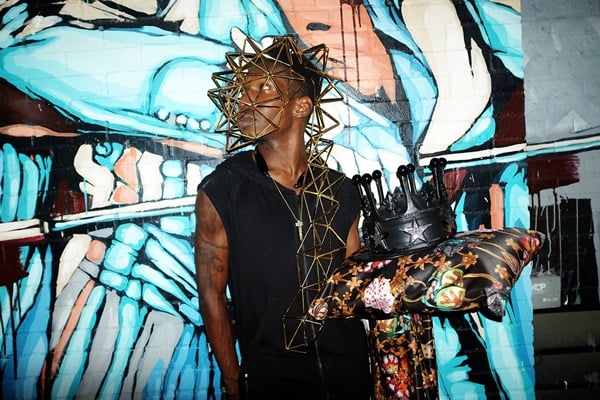
Photo: Elise Gallant.
Performer at Rashaad Newsome’s King of Arms Art Ball III.
Photo: Elise Gallant.
Twenty-five years after Jennie Livingston’s documentary Paris is Burning brought the underground ballroom scene—and voguing—to audiences worldwide, artist Rashaad Newsome is attempting to bring the art world into the ball scene. As part of that effort, he launched the third installment of his “King of Arms Art Ball” at Livestream Public, the former 3rd Ward space in Brooklyn’s Bushwick neighborhood on Sunday.
A wooden catwalk occupied one side of the space, where dancers would compete for prizes in categories such as Sex Siren, Face, and Runway. People lined up on both sides to get up close and personal with voguing legends from the House of Mizrahi as well as talented newcomers. Judges included art-world figures such as artist Mickalene Thomas, Studio Museum in Harlem curator Amanda Hunt, Contemporary Arts Center New Orleans director Neil Barclay, and ball royalty such as Tyra A. Moss, Lola Mizrahi, Erica Kane Lanvin.
The evening overall presented an awkward, but admirable, blending of worlds. The contest featured categories inspired by Nick Cave’s Soundsuits and El Anatsui’s glittering sculptures made from recycled liquor bottle caps. Even the judges got their moment on the catwalk. When the announcer called out, “Artist! Mickalene Thomas! Artist!”, Thomas dutifully strutted down the catwalk, jokingly waving at audience members.
Nick Cave-inspired performers at Rashaad Newsome’s King of Arms Art Ball III.
Photo: Elise Gallant.
However, other parts of the night were less inspired. At the “King of Arms Absolut Bar,” pink drinks were dusted with real gold leaves, and this ostentatious display of wealth tasted like Snapple. I immediately thought of David Cross‘s line about “tasteless, odorless gold” being placed atop his dessert. “If that isn’t the ultimate ‘fuck you’ to poor people, I don’t know what is,” he said in a 2008 skit.
But the ball scene is all about opulence denied—and achieved despite the challenges. As the emcee proclaims to a participant in Paris is Burning, “Everything is yours!” This attitude of queer empowerment works in opposition to the conspicuous consumption that has been on display of late in the overheated art market.
On a large TV screen behind the hardest-working bartenders in show business, bottles of Absolut appeared against a backdrop of shirtless whirling hip-hop dervishes and gold chains. I gazed out at the youthful crowd before us, filled with people who may not have even been born when the film made its debut. But beyond the veneer of bored and anxious youthful voyeurism were moments of real earnestness—one thing the ballroom scene can offer the art world. An emcee shushed the crowd, asking for a “moment of silence for our transgender brothers and sisters,” adding, “Without them the ballroom scene wouldn’t exist.” (Proceeds from the event were donated to the transgender wing of Black Lives Matter.)
Midway through the evening, Newsome took to the catwalk as the announcer shouted, “He is someone who fights for his community!” The ballroom scene is Latin, black, transgender, and queer in all senses. It is everything the mainstream New York art world is not. Newsome is aware of this, which is why he ensures that black bodies are visible on the catwalk, and on the walls, where projections of black women and men abound. He’s carved out a space for more voices to be heard, and subjects to be seen.
As drag legend Dorian Corey says in Paris is Burning, “You don’t have to bend the whole world. I think it’s better to just enjoy it. Pay your dues, and just enjoy it. If you shoot an arrow and it goes real high, hooray for you.”
A fourth installation, according to the New York Times, is in the works. See images from the event below.
“Sex Siren” category participant for Black Lives Matter.
Photo: Elise Gallant.
“Sex Siren” category participant for Black Lives Matter.
Photo: Elise Gallant.
Rashaad Newsome strikes a pose at his King of Arms Art Ball III.
Photo: Elise Gallant.
Judges at Rashaad Newsome’s King of Arms Art Ball III.
Photo: Elise Gallant.
MC at Rashaad Newsome’s King of Arms Art Ball III.
Photo: Elise Gallant.
Performance Legend at Rashaad Newsome’s King of Arms Art Ball III.
Photo: Elise Gallant.